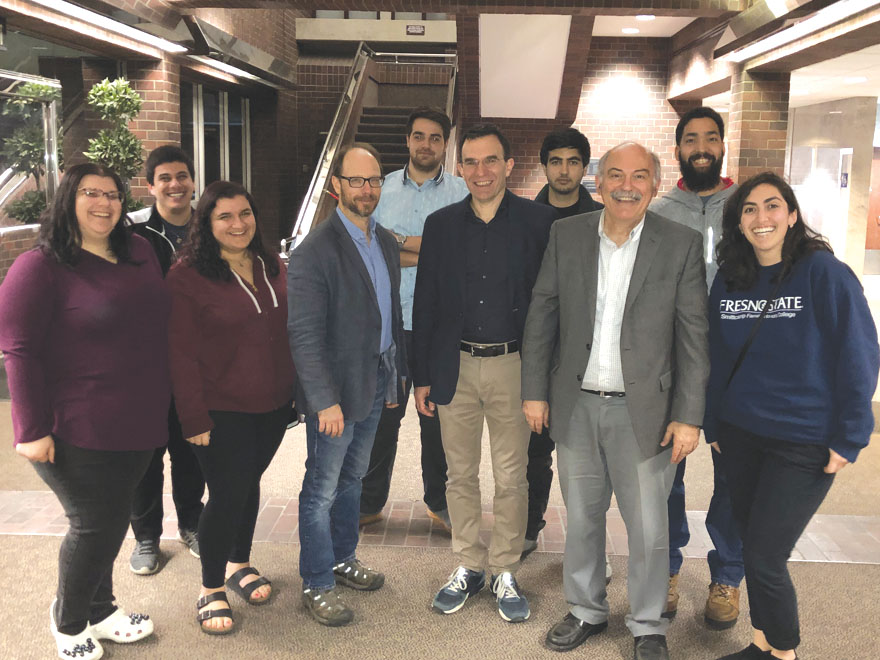
Photo: Christine Pambukyan
Annie Rubio
Editor
“Who is going to write our history?” This was the existential question that faced the first generation of the Armenian Diaspora, who were forced out of their homes and villages during the Armenian Genocide of 1915. Unable to return home, they relied on their memories to draw maps, write music, and record their memoirs. Today, these efforts are continued through the Berlin-based website Houshamadyan Project, founded in 2010, which compiles such memories and knowledge into an online archive.
The Armenian Studies Program invited Dr. Vahe Tachjian, director of the Houshamadyan Project, to present a talk on Monday, March 11, titled “How We Lived: The Houshamadyan Project,” as part of the ASP Spring Lecture Series.
Dr. Tachjian explained the goals of the website and then demonstrated how to navigate the different sections. With their teams of translators around the world, the Houshamadyan Project is able to bring back to life the cities, towns, and villages in which Armenians lived in the Ottoman Empire. There is a delicate balance between the need for a collective history and the subjectivity and sentimentality of the artifacts. While trying to recreate these memories, Tachjian said they must also consider, “How would the first generation Armenians want their history to be presented?”
The website itself is full of historical artifacts and resources for those wanting to learn more about the Armenian villages and cities in the Ottoman Empire. There are a variety of areas that can be accessed including information on schools, education and sport, religion, festivals and folk medicine.
There are maps of various regions, which can be narrowed down to the individual districts. Each region has a series of articles, with topics such as economy, religion, culture, and even food.
There is even a music area, with recordings of songs from different regions. Houshamadyan has taken these songs and created visual podcasts, where viewers can listen while watching animated photos from the region. Dr. Tachjian played a podcast from the Ourfa province, leaving the audience enamored with the moving images.
Houshamadyan has also incorporated the “Open Digital Archive,” which contains collec-tions of artifacts from individual families. It was originally de-signed as a way to organize the incoming collections from various families around the world. There are many collections from the United States, Canada, Argentina, Brazil and other places throughout the world.
As an example, Dr. Tachjian discussed the collection of Edwin Sadoian, who was in the audience. A new addition to the Houshamadyan website is “Voices,” an area for unique individual memoirs and larger bodies of text. Due to the rarity and lengthy translations required, there is only one item available so far in the section. To view the collections, or for more information regarding submissions of artifacts, please visit www.houshamadyan.org.
The Houshamadyan Project is always open for feedback on their entries, as it helps to verify the integrity and accuracy of the information. They verify information across several sources before posting articles, but as Dr. Tachjian said, “It is our job as sociologists to question sources.” Much of the website’s traffic has been from Turkey, especially the interior provinces that are described in these same articles. With this valuable feedback, Houshamadyan is able to create a collaborative space for individuals to contribute to this collective history.
Dr. Tachjian earned his Ph.D. in History and Civilisation at the École des Hautes Études en Sciences Sociales (EHESS) in Paris. He has been a frequent visitor to Fresno State. His main publications are: La France en Cilicie et en Haute-Méso- potamie. Paris, 2004; Les Arméniens, 1917-1939: La quête d’un refuge, Paris, 2007 (co-editor); and Daily life in the Abyss: Genocide Diaries, 1915-1918, New York/Oxford, 2017.
The Project has recently expanded and created the Houshamadyan Educational Foundation, a 501(c)(3) branch in Michigan.
 Hye Sharzhoom Armenian Action
Hye Sharzhoom Armenian Action